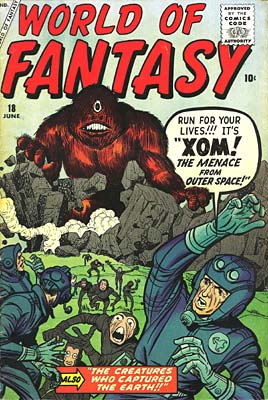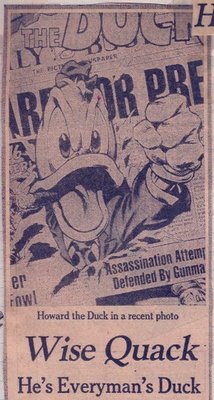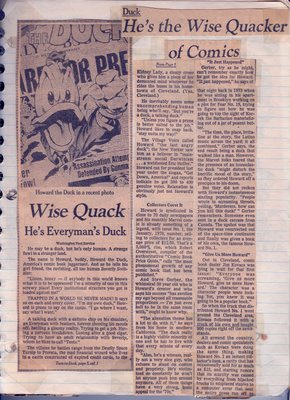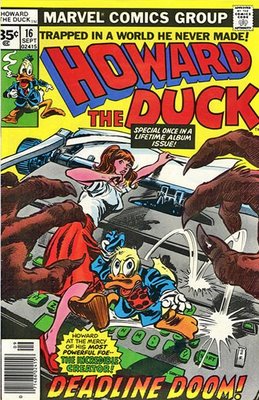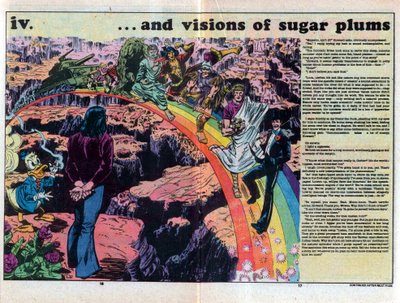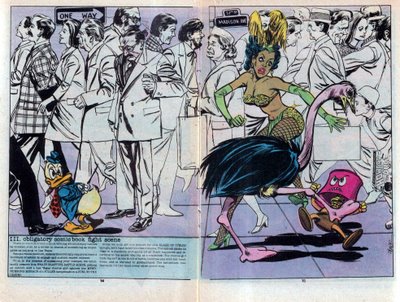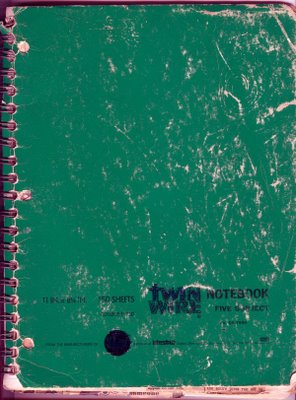Tales from the Green Scrapbook #2: Stan Lee - Man Behind a Marvel
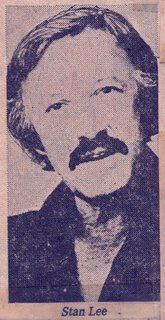 Hi, Heroes! Hang on to your hats - this episode of Tales from the Green Scrapbook spotlights the first newspaper article about Stan Lee I ever read. Sure, I'd read his essays in Origins of Marvel Comics, and I'd devoured all the comics reference books in my local library; but here was actual attention to my favorite comics writer in the daily newspaper. I couldn't grab the paper from my Dad's hands fast enough.
Hi, Heroes! Hang on to your hats - this episode of Tales from the Green Scrapbook spotlights the first newspaper article about Stan Lee I ever read. Sure, I'd read his essays in Origins of Marvel Comics, and I'd devoured all the comics reference books in my local library; but here was actual attention to my favorite comics writer in the daily newspaper. I couldn't grab the paper from my Dad's hands fast enough.What a disappointment. It's here I learned an important lesson: Never believe everything you read. Even at age eleven or so, I knew enough to recognize that the article was full of mistakes, from simple typos to downright errors of fact. And the accompanying illustration was wildly, laughably, and infuriatingly inaccurate. As a true-blue Marvelite, I was incensed!
Now, with the benefit of hindsight, I imagine that whoever had to write this (unsigned) piece knew next to nothing about the topic, if not less. I can't really fault the reporter: It's impossible for newspaper writers to be experts on everything they write, especially feature writers. How could they be? And there's only so much time for research, especially on deadline. But isn't an editor's job to make sure that the reporter gets the facts right? Or at least find a proofreader?
Maybe it's asking too much for complete accuracy in what was obviously considered a fluff piece. Thirty-some years ago (the approximate date of this article) the mainstream media's awareness of all matters comics was significantly lower than it is today. Furthermore, Lee's own public profile as the face and founding father of Marvel Comics (some would call that "inaccurate self-mythologizing") was still developing.
Still, my disappointment was palpable. I must have archived this article as a reminder that even I, at age eleven, was smart enough to recognize ignorance when I saw it.
So here we go: A picky, petty, unabashedly fanboy-ish deconstruction of the article's most glaring failings. For the maximum impact, imagine a serious young fan yelling out loud when he originally ran across each of the following passages.
This is The Geek Stuff.
 1: And artist, plotter, and arguably co-writer Jack Kirby was who? (In all fairness to Stan, the reporter doesn't give this as a quotation. He's long said that he'd always talked about the artists with reporters, but that they often left that part out. I believe Lee, especially given that he does gush about artists like Kirby and Steve Ditko throughout Origins of Marvel Comics.)
1: And artist, plotter, and arguably co-writer Jack Kirby was who? (In all fairness to Stan, the reporter doesn't give this as a quotation. He's long said that he'd always talked about the artists with reporters, but that they often left that part out. I believe Lee, especially given that he does gush about artists like Kirby and Steve Ditko throughout Origins of Marvel Comics.)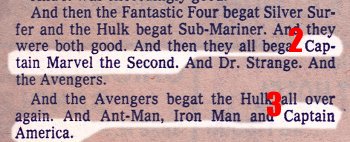 2: Who? OK, They mean Marvel's Captain Marvel (actually Mar-vell, a Kree-born warrior - don't ask), not the Big Red Cheese who shouts "SHAZAM!" The character allowed Marvel to claim and trademark the character-name, a decade after Fawcett Comics lost a lawsuit to DC and had to cease publication of the original Captain Marvel. Stan did write the first appearance of Marvel's Marvel, but Roy Thomas took over the scripting duties with the next issue. I wouldn't be surprised if it was all Thomas' idea, with Lee there just to lend the first appearance more "authenticity." So: "The Second"? Not only did Stan probably not create the character, as the article implies, but that nomenclature is just wrong, wrong, wrong! (Remember, you were warned that there would be some picky fanboy stuff...)
2: Who? OK, They mean Marvel's Captain Marvel (actually Mar-vell, a Kree-born warrior - don't ask), not the Big Red Cheese who shouts "SHAZAM!" The character allowed Marvel to claim and trademark the character-name, a decade after Fawcett Comics lost a lawsuit to DC and had to cease publication of the original Captain Marvel. Stan did write the first appearance of Marvel's Marvel, but Roy Thomas took over the scripting duties with the next issue. I wouldn't be surprised if it was all Thomas' idea, with Lee there just to lend the first appearance more "authenticity." So: "The Second"? Not only did Stan probably not create the character, as the article implies, but that nomenclature is just wrong, wrong, wrong! (Remember, you were warned that there would be some picky fanboy stuff...)3: Captain America: Created by Joe Simon and Jack Kirby. In 1940. Can you "beget" something that was already begat nearly a quarter-century beforehand? No.
 4: No, Xom was "The Menace from Outer Space!" We have archaeological evidence to confirm this:
4: No, Xom was "The Menace from Outer Space!" We have archaeological evidence to confirm this:5: Thomgarr did not exist, as far as my research has been able to determine, and therefore was not an alien, anti-social or otherwise.
(I imagine that either Lee or the reporter weren't striving for accuracy here; they most likely just dreamed up these titles because they sounded right enough. But still.)
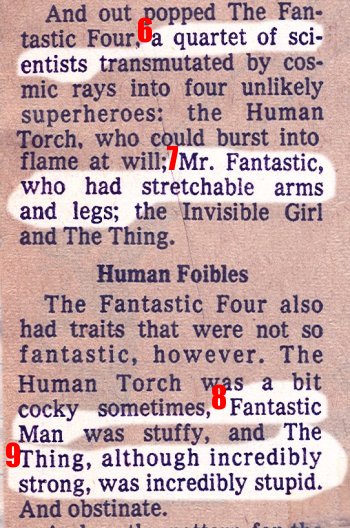 6: Reed was the only scientist. Ben was a test pilot, Sue was "the girlfriend," and Johnny was "the girlfriend's little brother." (Really, Ben should have been the only one qualified to fly in that rocket. Maybe Reed as well, since he designed it, but it's doubtful that his scrawny frame would have survived training. But Sue? Johnny? Really? Although I hardly gave questions like those more than a passing consideration back then...)
6: Reed was the only scientist. Ben was a test pilot, Sue was "the girlfriend," and Johnny was "the girlfriend's little brother." (Really, Ben should have been the only one qualified to fly in that rocket. Maybe Reed as well, since he designed it, but it's doubtful that his scrawny frame would have survived training. But Sue? Johnny? Really? Although I hardly gave questions like those more than a passing consideration back then...)7: His whole body, dangit!
8: Who?
9: It's not The Thing who's the stupid one here. (He's not always the smartest tool in the shed, granted, but an "incredibly stupid" test-pilot wouldn't last long, would he?)
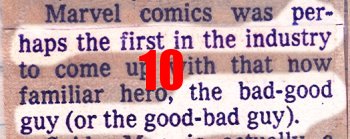 10: I suppose we can give this one a pass. I'm not sure if he's actually the first of these characters, but Prince Namor, the Sub Mariner, who first appeared in Marvel Comics #1 (Nov. 1939), does fit the description. Although Stan had nothing do to with creating the character.
10: I suppose we can give this one a pass. I'm not sure if he's actually the first of these characters, but Prince Namor, the Sub Mariner, who first appeared in Marvel Comics #1 (Nov. 1939), does fit the description. Although Stan had nothing do to with creating the character.And "anti-hero" would have saved a whole line of type.
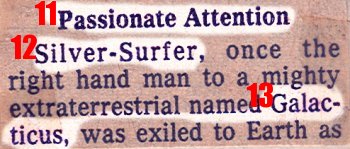 11. Not by anyone involved with this article...
11. Not by anyone involved with this article...12. Not-exactly.
13. Is he not... Galactus?!!
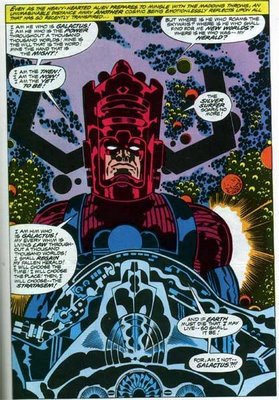 I thought so.
I thought so.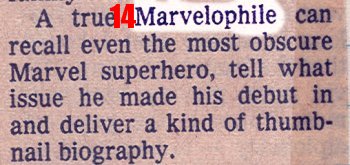 14: Marvelite. Or True Believer. Or Marvel Zombie. Marvelophile just sounds stupid.
14: Marvelite. Or True Believer. Or Marvel Zombie. Marvelophile just sounds stupid.OK, that's the worst of the text. Now let's check out the accompanying illustration. It's a collage purporting to represent "Some of Stan Lee's comic characters." There's no wonder why the illustrator didn't take any credit, or that there are no copyrights listed.
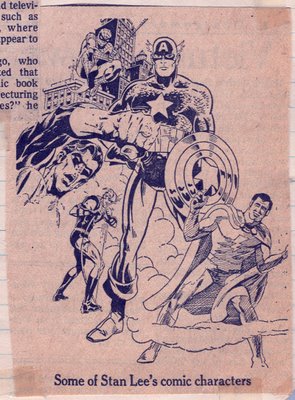 Hommina hommina hommina WHA?
Hommina hommina hommina WHA?I didn't get it then, and I don't get it now. The only thing I can imagine is a scenario involving dialog like this:
"We've got space to fill on that funnybook article. I think it's about superheroes or something? Hey, you! Designated office flunky! Head to the comic book clip-art file and throw something together. With your eyes closed. And be sure to use at least one image from the 'Amateur Renderings' box. STAT!"What else could result in a collage where arguably 70% of the content should not be there? Let's break it down, with visual emphasis or de-emphasis as necessary:
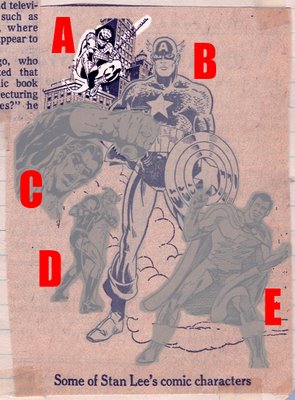 A) Spider-Man: Check. Co-created with Steve Ditko. (Yes, there are arguments that Kirby should receive credit. And Jonathan Ross got Stan to admit that, deep down, he feels that Spider-Man is his creation alone.) Even given those controversies, I'll say "full credit"; at least Lee wrote the character from the very beginning: 20%
A) Spider-Man: Check. Co-created with Steve Ditko. (Yes, there are arguments that Kirby should receive credit. And Jonathan Ross got Stan to admit that, deep down, he feels that Spider-Man is his creation alone.) Even given those controversies, I'll say "full credit"; at least Lee wrote the character from the very beginning: 20%B) Captain America: See #3 above. However, Stan did write the character for quite a long time, and along with Kirby he re-introduced Cap in Avengers #4. So half-credit: 10%
C) Green Lantern: Published by DC Comics, not Marvel. Stan had absolutely nothing to do with this character. At all. Ever. (This book does not count, fanboys.) 0%
D) Green Arrow: Published by DC Comics, not Marvel. Stan had absolutely nothing to do with this character. At all. Ever. 0%
E) The SHAZAM! Captain Marvel: By this time, SHAZAM! was owned and published by DC. Stan had absolutely nothing to do with this character. At all. Ever. (This book does not count, fanboys.) I'd almost be tempted to give this one 5%, just because of the possible confusion noted in #2 above. But not with a horrendous drawing like that; no freakin' way. 0%
And now, the whole thing:
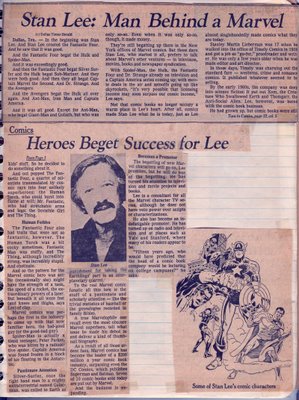
OK, that's far more than enough on this one. But thanks for indulging me; my inner eleven-year-old has been waiting 30 years to get this off his chest.
There. Now I feel cleansed.
Be sure to join us next time on Tales from the Green Scrapbook, when we spotlight America's war on terrorists - thirty years ago...
More from The Green Scrapbook: Part 0: Intro || Part 1: Howard the Duck
Labels: Milwaukee Journal, newspapers, Stan Lee, superheroes, Tales from the Green Scrapbook
